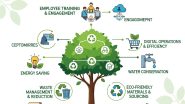?Introduction
- Do you have a Standard Operating Procedure in your business?
- Do you want to build a process-oriented organization?
Usually, there are two types of business - ’Personality-oriented’ and ’Process-oriented’ organization.
Difference between Personality-Oriented and Process-Oriented Organization
| Personality-Oriented Organization | Process-Oriented Organization |
| If one person is there, the business will be great; else in his absence, things will just not work properly. | A business runs on the basis of set standard operating procedures, regardless of whether the owner is present or not. |
| All small food courts are personality-driven business where the starter needs to be present for giving the best service or food. | QSRs like burger king and Mc. Donald’s are very good examples of a Process-driven business. |
| There is a risk of knowledge loss because everything is not well written and well-formatted so it remains in the minds of people who are an expert. | Here, you have a written manual which can be transferred to whosoever comes, you can give them the manual and ask them to read it and work accordingly. |
| The person could destroy your company, join the other competitor or himself become one. | Your training cost minimizes and with regular tests your new guy is ready and expert. |
You need to have a process-oriented organization if you are looking for expansion.
So, now what should be done to get this?
The easiest way is to develop SOPs in every department.
Now, what is SOP? It means Standard Operating Procedure.
Advantages of SOP
1. Scaling up the Business
It leads to fast expansion. Take an example that if you have a shop in Delhi and want to expand it to the other cities of Rajasthan then what you have to do is create an SOP and send it to the other branches.
All of them will follow the same procedure that you are following.
It is one of the benefits of a process-based organization.
2. Efficiency
Standard Operating Procedure also ’increases the efficiency’
of the company, by ’streamlining the whole process’
in a sequence.
of the company, by ’streamlining the whole process’
in a sequence.
It is another benefit of the process-based organization.
3. Quality
The quality increases and becomes consistent. That is because all of the branches have the same procedure, the parameters are the same, so it keeps the quality as it is.
It is the third benefit of the process-based organization.
4. Uniformity in Performance
It is the fourth benefit of the process-based organization.
The performance will have uniformity. The outcome will always be the same and it will be repeated over and over again.
5. Miscommunication will Minimize
It is one of the benefits of a process-based organization.
The problems that would be leading to miscommunication will reduce and it will significantly minimize the failure.
| You should always make SOPs of execution and not of strategies. |
Convert Personality-oriented Organization to Process-oriented Organization
Now let's see the steps to convert your ’personality-oriented’ organization into a ’process-oriented’ organization.
Step #1: Identify the Problem for which you need the Process
It is the first step to process-oriented organizations.
Now first and the foremost thing you need to do is to ’identify the problem that is facing frequent critics, quality issues, productivity problems, outcome issues, calculation issues, accounting, and sales problem’
so that you can stop them from happening again.
so that you can stop them from happening again.
Step #2: Build the Process Boundary
It is the second step to process-oriented organizations.
What does this mean? Make a start point and an endpoint for this. And once you are clear with this, the next step will include the input and final output.
It means you will have to see what all things are going to be included between the first and the last point.
Step #3: Brainstorm Around all the Activities with your Team
After the completion of the first two steps, the next step to process-oriented organization is to you will have to ’brainstorm all the activities with your team’ and the first thing in this is to ’arrange everything in a sequence’ and then see where the manpower is needed.
Step #4: Put Process Role in a Flowchart for the Integrated Review
There are three things that you need to be very careful about this. And that is process role, flowchart, and an integrated review. Now, when you know what is everybody’s role arrange them in an assembly and let them know how to go for it.
It is the fourth step to process-oriented organizations.
As an example, in a car workshop, one team settles the chassis, the other does the vinyl, and others fit the headlamps and taillights. You have to work in the same fashion.
Step #5: Kill the Potential Problem in Advance with RACI Matrix
It is very obvious that at times you will have bad times where your products will face critics. So, to eliminate this you can pre-ready the RACI matrix.
It is the fifth step to process-oriented organizations.
| RACI means: R = Responsible | A=Accountable| C=Consultant | I=Informed |
All of them are connected to each other.
- When the responsible person finds any problem he informs the accountable person
- Then they go to the consultant who is the super-specialist
- Then they inform the informed authority.
| For Example In a hotel, cleaning staff is the ’responsible’ people who keep things fine and cleaned. The ’accountable’ people are those who is the floor manager and who comes in to check everything. Then there is a ’specialist’ who gives the remedies to every problem that they face. And then the last stage includes ’informing’ the General Manager who is the head. Building a hotel requires many departments so make various SOPs and then whenever a new person comes in, give it to them and your business will work just fine. |


















